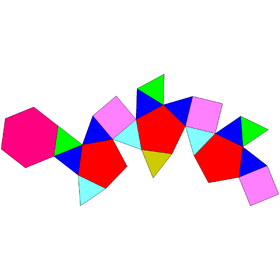In geometry, the triangular hebesphenorotunda is a Johnson solid with 13 equilateral triangles, 3 squares, 3 regular pentagons, and 1 regular hexagon, making the total of its faces is 20.
| Triangular hebesphenorotunda | |
|---|---|
 | |
| Type | Johnson J91 – J92 – J1 |
| Faces | 13 triangles 3 squares 3 pentagons 1 hexagon |
| Edges | 36 |
| Vertices | 18 |
| Vertex configuration | 3(33.5) 6(3.4.3.5) 3(3.5.3.5) 2.3(32.4.6) |
| Symmetry group | C3v |
| Dual polyhedron | - |
| Properties | convex |
| Net | |
 | |

Properties edit
The triangular hebesphenorotunda is named by Johnson (1966), with the prefix hebespheno- referring to a blunt wedge-like complex formed by three adjacent lunes—a figure where two equilateral triangles are attached at the opposite sides of a square. The suffix (triangular) -rotunda refers to the complex of three equilateral triangles and three regular pentagons surrounding another equilateral triangle, which bears a structural resemblance to the pentagonal rotunda.[1] Therefore, the triangular hebesphenorotunda has 20 faces: 13 equilateral triangles, 3 squares, 3 regular pentagons, and 1 regular hexagon.[2] The faces are all regular polygons, categorizing the triangular hebesphenorotunda as the Johnson solid, enumerated the last one .[3] It is one of the elementary Johnson solids, which do not arise from "cut and paste" manipulations of the Platonic and Archimedean solids.[4]
The surface area of a triangular hebesphenorotunda of edge length as:[2]
Cartesian coordinates edit
The triangular hebesphenorotunda with edge length can be constructed by the union of the orbits of the Cartesian coordinates:
References edit
- ^ Johnson, N. W. (1966), "Convex polyhedra with regular faces", Canadian Journal of Mathematics, 18: 169–200, doi:10.4153/cjm-1966-021-8, MR 0185507, S2CID 122006114, Zbl 0132.14603.
- ^ a b c Berman, M. (1971), "Regular-faced convex polyhedra", Journal of the Franklin Institute, 291 (5): 329–352, doi:10.1016/0016-0032(71)90071-8, MR 0290245.
- ^ Francis, D. (August 2013), "Johnson solids & their acronyms", Word Ways, 46 (3): 177.
- ^ Cromwell, P. R. (1997), Polyhedra, Cambridge University Press, p. 87, ISBN 978-0-521-66405-9.
- ^ Timofeenko, A. V. (2009), "The non-Platonic and non-Archimedean noncomposite polyhedra", Journal of Mathematical Science, 162 (5): 717, doi:10.1007/s10958-009-9655-0, S2CID 120114341.